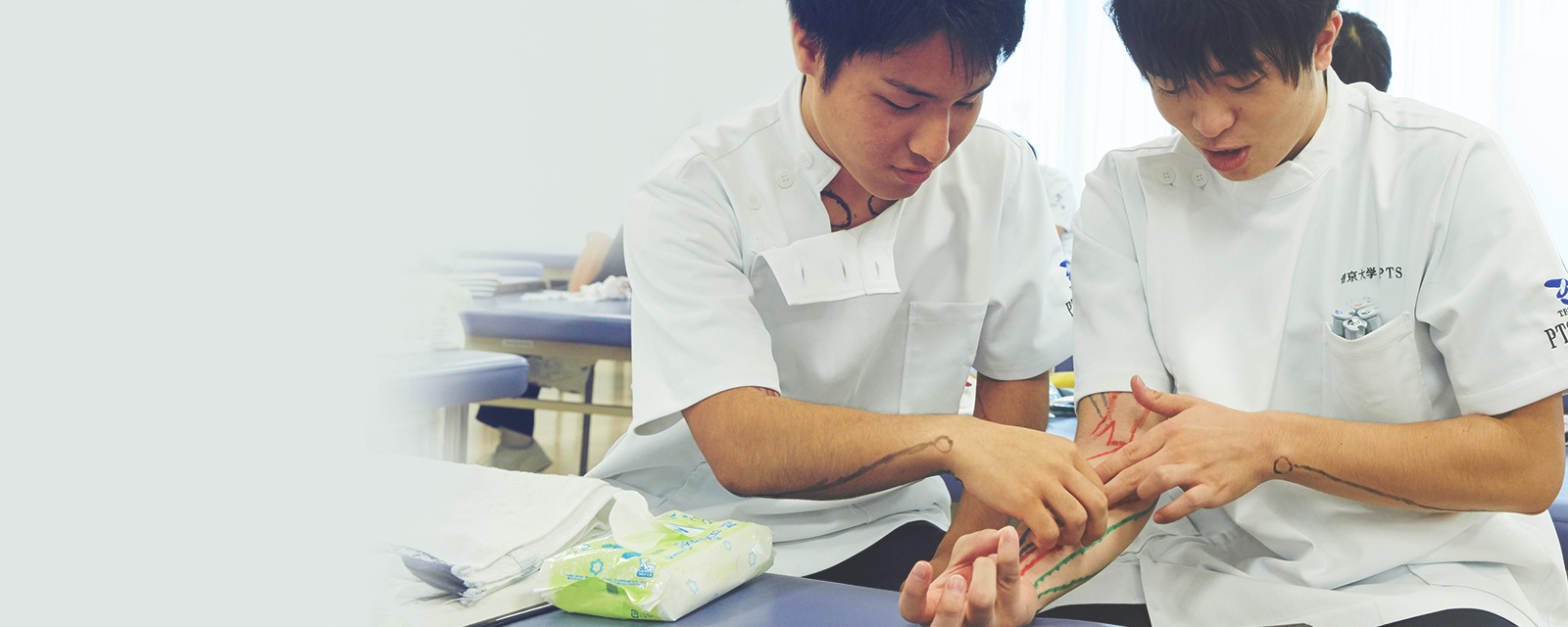
- 福岡キャンパス
福岡医療技術学部 理学療法学科

- 福岡キャンパス

リハビリテーションにより幅広い分野で
人と社会を支える人材を育成します
病気、怪我、高齢などで体が不自由になった患者さんに対して身体機能の回復、維持をめざして行う理学療法は、QOL(生活の質)という観点から、近年ますます要望が高まっています。理学療法学科では地域の医療機関などでの臨床実習を通して実践的な教育を行い、医療、保健、福祉、介護、スポーツなど幅広い分野で活躍できる理学療法士を養成します。
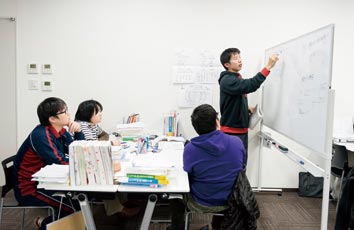
生徒間で相互の交流を図る「ゼミ制」
理学療法学科では、授業で学ぶ科目の勉強だけではなく、学年相互の交流を図り「実学」を学内でより多く経験させ、より人間味ある専門性豊かな学生を育てることを目的として、1〜4年次まで各学年10名前後のゼミ制を採用しています。
1~2年次は基礎医学の知識から臨床実習を通した主要疾患に対する評価の基礎へと学びを進めます。3〜4年次は実習が本格化。病院や施設などの現場で理学療法評価を学び、長期間にわたって患者さんに対応する実習を通して技術を身につけ、国家試験へと挑みます。また、希望者にはアメリカで国際感覚と実践を学ぶ海外実習もあります。
解剖学実習
体の正常な構造について理解を深めるために、人体骨格標本や人体模型標本による実習、体表からの触察、さらに解剖学実習見学を行います。特に体表からの触察法を十分に習得することを目標にします。医療における根本は解剖学であり、すべての専門科目において解剖学は深く関連しますが、特に理学療法の徒手による操作であり、身体を触知することができなければ、決して行うことはできません。したがって解剖学実習は基本中の基本といえます。講義の進行は、体表から触知できるおのおのの筋・骨・神経について説明し、デモンストレーションを行ったあと学生同士で実技を行います。
運動療法学概論
理学療法士の医療サービスの代表的な運動療法を、専門基礎科目(解剖学・生理学)をもとに理学療法の対象疾患である運動器系・中枢神経系・内部障害系の関連医学ならびに運動治療学などの基礎理論を背景とした各種運動療法を学びます。実際の運動療法学を学ぶ前提として、骨格筋の構造、筋の収縮様式、随意運動やその制御・運動学習についてしっかりと復習します。また、運動のエネルギーとなる呼吸・循環・代謝についても運動の関係性を復習します。その後、運動療法の中心である関節可動域運動・筋力増強運動の理論とその方法について学習を進めます。また、協調性障害・持久力増強・認知障害・痛みに対する運動療法について学習します。
物理療法学
物理療法は温めたり、電気を流したりすることで理学療法士による治療の効果をより効率よく上げる手段として用いられます。身近なものとして、お風呂やコタツも物理療法の一種といえるでしょう。物理療法機器は身体に物理的エネルギーを与えることで生体反応を引き起こし、症状を改善させることが目的ですが、なかには生体反応を引き起こすことで症状を悪化させてしまうリスクも伴います。物理療法学では物理エネルギーがどのように生体反応を引き起こすか、さらに牽引療法・水治療法・温熱療法・寒冷療法・電気療法・光線療法などの各種物理療法機器に関する特徴や操作方法、実際に患者さんに使用する場合の一連の流れやリスク管理などの学習を行います。
動作解析学
理学療法の治療対象である身体の動きを理解し、その知識を治療に反映することは、理学療法の発展のために重要です。運動面から定量的に解析するために必要な基礎的技術を学習し、運動分析の手法として、運動学的分析、運動力学的分析の測定原理と技術を習得することを目的とします。また、正常動作を理解することが異常を理解するために役立つこともあり、異常を理解することが正常を理解することに役立ちます。動作を“どのように分析していくか”を立ち上がり動作と歩行動作を実際に分析して正常動作・異常動作を理解します。
神経系理学療法治療学演習
神経系理学療法治療学演習は神経系理学療法治療学Ⅰ・Ⅱで学んだ知識をもとに、その障がい像をイメージしながら実技を通して、成人中枢神経疾患(脳血管障がい)に対する基本的な運動療法を実施することを目的とします。脳血管障がいは、脳の損傷部位により麻痺の部位(片麻痺・四肢麻痺など)や程度(弛緩性麻痺・痙性麻痺など)のさまざまな運動障がいを呈します。それらの錐体路障害を中心に典型的な運動麻痺例の脳血管障がい発症後からの経過に沿った代表的なアプローチを、「1.愛護的な関節可動域運動について」「2.片麻痺の方への特徴的な各動作やそれらの「介助方法」について」「3.片麻痺に対する特殊手技(PNFを中心に)について」の3項目を主軸とし、実技を中心に学習します。また理学療法プログラム実施時に必要な基本的な運動療法技術、日常生活活動の回復に向けた介助やその指導技術を学びます。
2年次から始まる臨床実習は、卒業までに合計約18週間の長期におよびます。実習は、授業で修得した知識や経験に合わせて、年次ごとに異なる病院や施設が設定されており、さまざまな場所で治療経験を重ねることで、リハビリテーションの多彩なフィードバックとさまざまな治療方法を実践的に学習します。
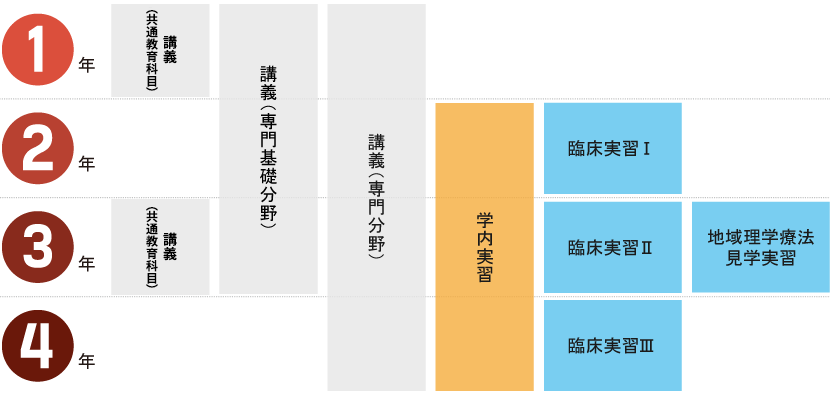
臨床実習の期間は、2年次約2週間、3年次約10週間、4年次約8週間となります。実習はそれぞれ異なる病院や施設で実施します。臨床の現場で患者さんと接することで、授業の理解を深めていきます。
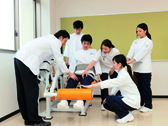
臨床実習Ⅰ
2年次の2月に行う2週間の臨床実習Ⅰが、理学療法士をめざす実習のスタートとなります。実習では、病院や施設の現場で、1〜2年次に学んだ知識や技術を踏まえ、指導者の指導を受けながら理学療法士に必要な基本的知識と技術を学んでいきます。医療面接、検査・測定など、監視下で参加が可能な範囲の体験・学習も行います。また、患者さんや他の職種とのコミュニケーションを図り関係を築きながら、医療スタッフとしての職業的態度、倫理観も養います。この実習前には3年生に被験者になってもらい、OSCE(客観的臨床能力試験)を実施しています。
臨床実習Ⅱ
3年次には、秋に4週間、冬に4週間と臨床実習が本格化します。実習前に、ゼミにおいて検査測定技術の再確認と理学療法評価の流れの習熟を徹底、OSCE(客観的臨床能力試験)も実施します。実習では引き続き、病院や施設などで理学療法士の知識と技術を学びます。参加が可能な範囲の情報収集を監視下で行うのは2年次と同様ですが、この学年では、得られた情報を使用して障がいの解釈を行い課題を抽出、それに対する理学療法治療計画の立案を行えるまでになることをめざします。
臨床実習Ⅲ
4年次では、5月または8月に、8週間という長期間連続した現場実習を行います。実習前のゼミで、自らの評価実習の課題を抽出しその課題解決のための計画を立案・実施。またグループ学習により、解剖学・生理学・運動学の知識を向上させ、その上で長期の実習に挑みます。この年次では、指導者が行う理学療法業務を見学しながら患者の問題点などから臨床推論法を考えるなど、一層実践的に学んでいくことが求められます。
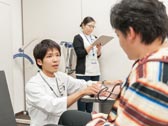
OSCE(客観的臨床能力試験、通称「オスキー」)とは、すでにカナダの医師国家試験や米国の専門医試験等で採用されている医学生等の基本的な臨床技能を客観的に評価するための試験です。理学療法学科では実学の精神に基づき、基本的臨床スキルと態度を備えるために、2年次・3年次の実習前後にOSCEを実施しています。
帝京大学医学部附属病院、大牟田市立病院、九州大学病院、九州労災病院、久留米リハビリテーション病院、杉循環器科内科病院、誠愛リハビリテーション病院、永田整形外科病院、福岡県済生会大牟田病院、福岡市民病院、福岡リハビリテーション病院、ヨコクラ病院、鶴田整形外科、朝日野総合病院、熊本機能病院、熊本整形外科病院、熊本大学病院、熊本労災病院、成尾整形外科病院、大分中村病院、藤元総合病院、宮崎善仁会病院、米盛病院、琉球大学病院 ほか
(2025年4月現在)
成績評価制度として、GPA制度を導入しています。学修成果をGPAという客観的な数値で評価することにより、成績評価をより明確にし、学生の皆さんの学修指導に役立てることを目的としています。また、この制度は欧米の大学で一般的に採用している成績評価制度に概ね準拠しています。

| 評価点 | 評価 | GP | 合否 |
|---|---|---|---|
| 90点以上 | S | 4.0 | 合格 |
| 80点台 | A | 3.0 | |
| 70点台 | B | 2.0 | |
| 60点台 | C | 1.0 | |
| 認定 | N | 対象外 | |
| 保留 | H | 対象外 | 保留 |
| 60点未満 | D | 0.0 | 不合格 「成績証明書」には記載されません。 |
| 試験欠席 | 欠席 | 0.0 | |
| 受験資格無し | 無資格 | 0.0 | |
| 休学 | K | 対象外 | |
| 放棄 | 放棄 | 0.0 | |
| 要件外科目 | Y | 対象外 | 要件外 |
福岡医療技術学部における学修は単位制に基づき行われます。単位制とは、すべての科目に一定の単位数が定められ、その科目の授業および準備学修(予習・復習など)の後、試験やその他の方法によって合格した場合に、その定められた単位数を修得することをいいます。
科目には、講義・演習・実験・実習・実技の5種類があり、特別な科目以外は半期で終了します。それぞれの科目は次の基準によって計算します。各科目の単位数は、履修表を参照してください。また、当然ながら準備学修(予習・復習など)も必要です。シラバスでは準備学修について説明をしていますので、計画的に学修を進めてください。
単位
学修時間を基に決められており、授業の方法および授業の教育効果などを考慮し、1単位は45時間(講義の場合、授業15時間、予習15時間、復習15時間)の学修が基準です。
| 授業の方法 | 授業時間 | 準備学修(予習・復習など) |
|---|---|---|
| 講義・演習 | 15~30時間 | 30~15時間 |
| 実験・実習・実技 | 30~45時間 | 15時間 |
科目の受講が終了し、試験に合格したものと認定されると、その科目の単位を修得したことになります。卒業要件に1単位でも不足すると卒業できません。計画的に履修していくようにしましょう。
| 科目区分 | 必修・選択の別 | 所要単位数 |
|---|---|---|
| 共通教育科目 | 必修 | 17 |
| 選択 | 3 ※ | |
| 専門基礎分野 | 必修 | 40 |
| 専門分野 | 必修 | 65 |
| 選択 | 3 | |
| 合計 | 128 | |